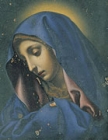Japanese Gallery (Honkan) Room T1
August 4, 2009 (Tue) - September 6, 2009 (Sun)
The Tokyo National Museum collection includes 541 objects related to Christianity in pre-modern Japan. The majority of these items were seized from local Christians by the magistrate of Nagasaki, and were transferred from the Ministry of Home Affairs' Shrines and Temples Bureau to the Tokyo National Museum in 1879. Thematic exhibitions of Christian objects are held at the museum on an almost annual basis. This year's exhibition is centered around images of the figure known in Christianity as the Virgin Mary, or the Madonna.
Many images of the Madonna were brought to Japan by Spanish Jesuit Francisco de Xavier when he arrived in Satsuma province, Kyushu, in 1549. Later, portraits of saints and biblical figures began to be produced domestically at a painting school opened by Jesuit missionary Alessandro Valignano, with the help of Italian painter Giovanni Nicolao. Portraits of the Madonna were particularly cherished among Christians in Japan, and stories remain associating these works with miracles. One such story cites the case of a seriously ill young girl from Arima, who was reportedly healed by a visitation from the Virgin Mary, said to have materialized one night from a painting in the girl's room.
Following the anti-Christian edict of 1614, however, the possession of images of the Madonna was prohibited and Christians began to worship figures of the Buddhist child-protecting deity Koyasu Kannon as the Virgin Mary.
Images of the Madonna both large and small can be found in a variety of objects which once belonged to Christians in Japan, including paintings, bronze medallions, crucifixes and rosary beads. This exhibition showcases a wide variety of these images, including the Madonna of the Thumb, said to have been brought to Japan by Italian missionary Giovanni Sidotti who was captured after entering the country illegally; "Maria Kannon" statues, which were worshipped as a substitute for idols of the Virgin Mary; and so-called fumi-e (literally "trodden pictures"), which were used to expose Christians during the time of prohibition. The exhibition also includes a plaster reproduction of a Madonna statue which was brought to Japan from Germany during the Meiji period, and a copy of a Madonna portrait produced by painter Shimomura Kanzan in London, after an original by Renaissance artist Raffaello Santi.

